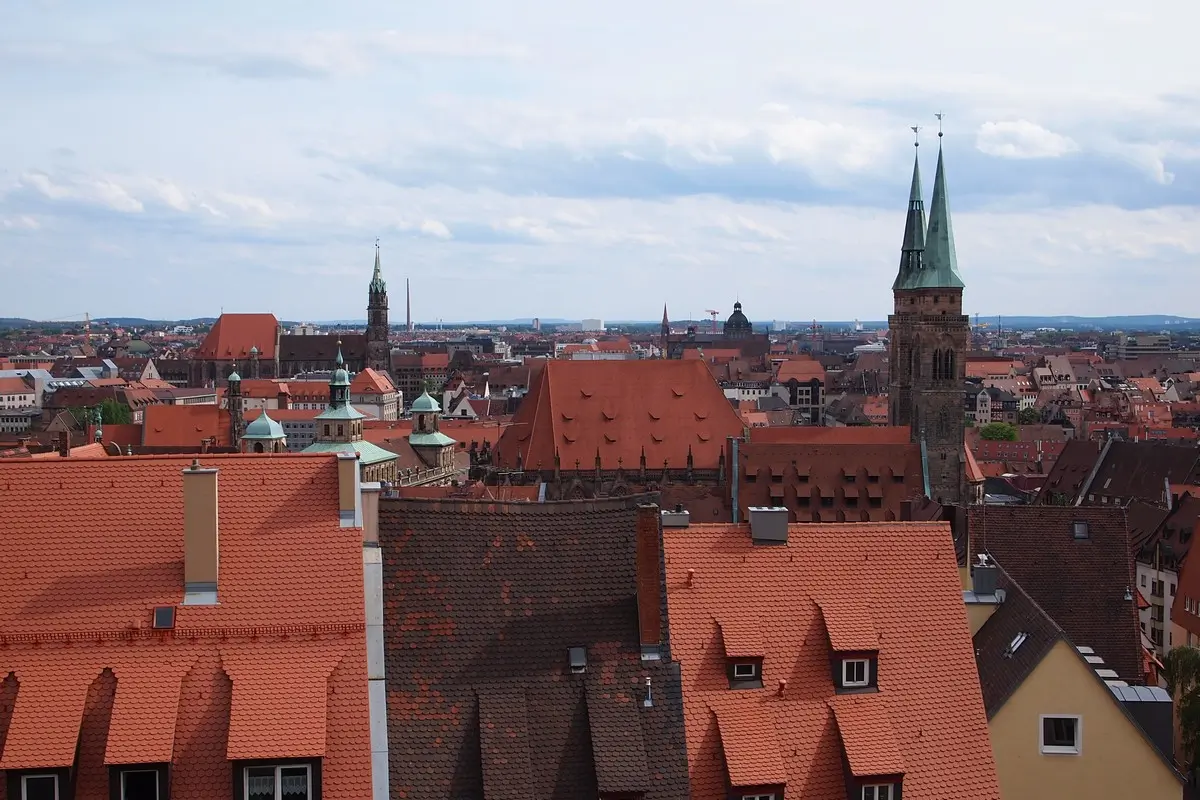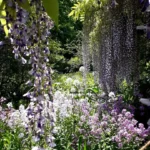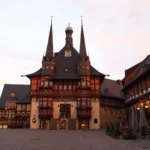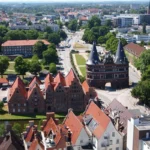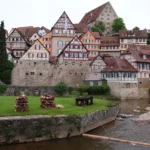Last Updated on 25/10/2023
Nuremberg (Nürnberg) is a great intermediate point on the way somewhere. Here you can not only spend the night, but also see something, limit yourself to half a day or spend a couple of days. It is easy to find attractions in the area for a week. But for a long stay, I would choose another city for the accomodation.
In other posts, see photos from the very good Nuremberg Zoo, and about the Franconian Switzerland and maps of the region.
it can be also interesting:
Dennelohe. Rhododendron Garden
Castle Road. 3. From Sinsheim to Rothenburg ob der Tauber
Romantic Franconia map
Before the war, Nuremberg was a very beautiful city, as can be seen from old photographs. Its greatest flowering was in the Middle Ages. And in the Baroque era, when many cities were rebuilt in a new style, Nuremberg was in decline. This allowed the old architecture to be preserved in large numbers.
But during the war, as one of the places most associated with the Nazis, it was bombed almost to zero. Little has survived or been restored: the walls of the city, a fortress, several cathedrals, a small number of old houses. There are a couple of very good museums, a zoo with a dolphinarium.
The Christmas market in Nuremberg is especially strongly promoted, but at this time there is a complete overcrowding with tousands of people. Therefore, it may be more correct to choose something less popular. In fact, all the major German Christmas markets are not very different from each other.
Attractions of the Nuremberg old town
The Nuremberg old town – the space that is surrounded by the city wall – is unexpectedly large in size. Therefore, an unprepared visit can be very unproductive: you need to find pearls among many much less interesting houses. The tourist office will not help you too much – the choice of brochures is pathetic.
Let’s take an approximate route through the city and try to cover the most interesting. The route does not include the city walls surrounding the old town. They were created in the middle of the 15th century and are integrated with the fortress and previous fortifications, from which towers remain in some places. Almost along the entire perimeter, these walls and towers are either preserved or have been restored.
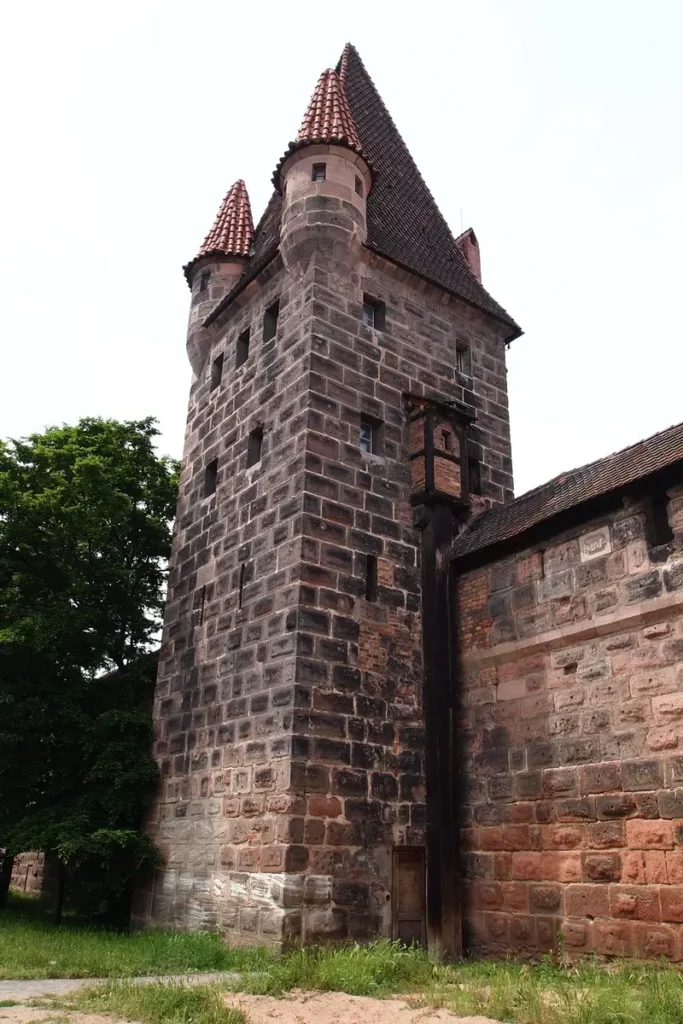
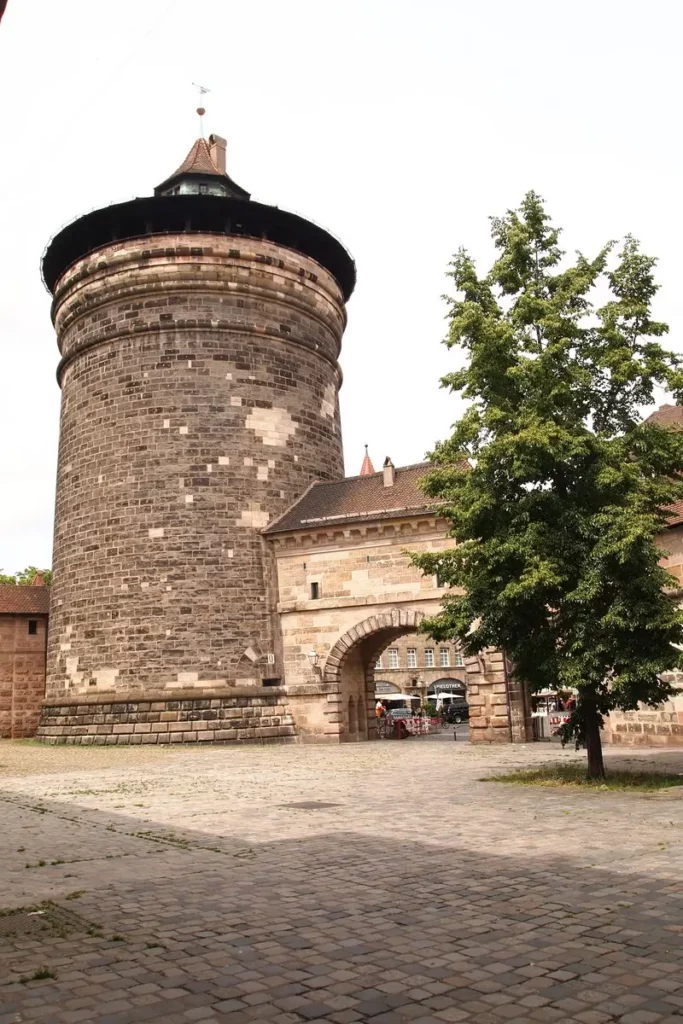
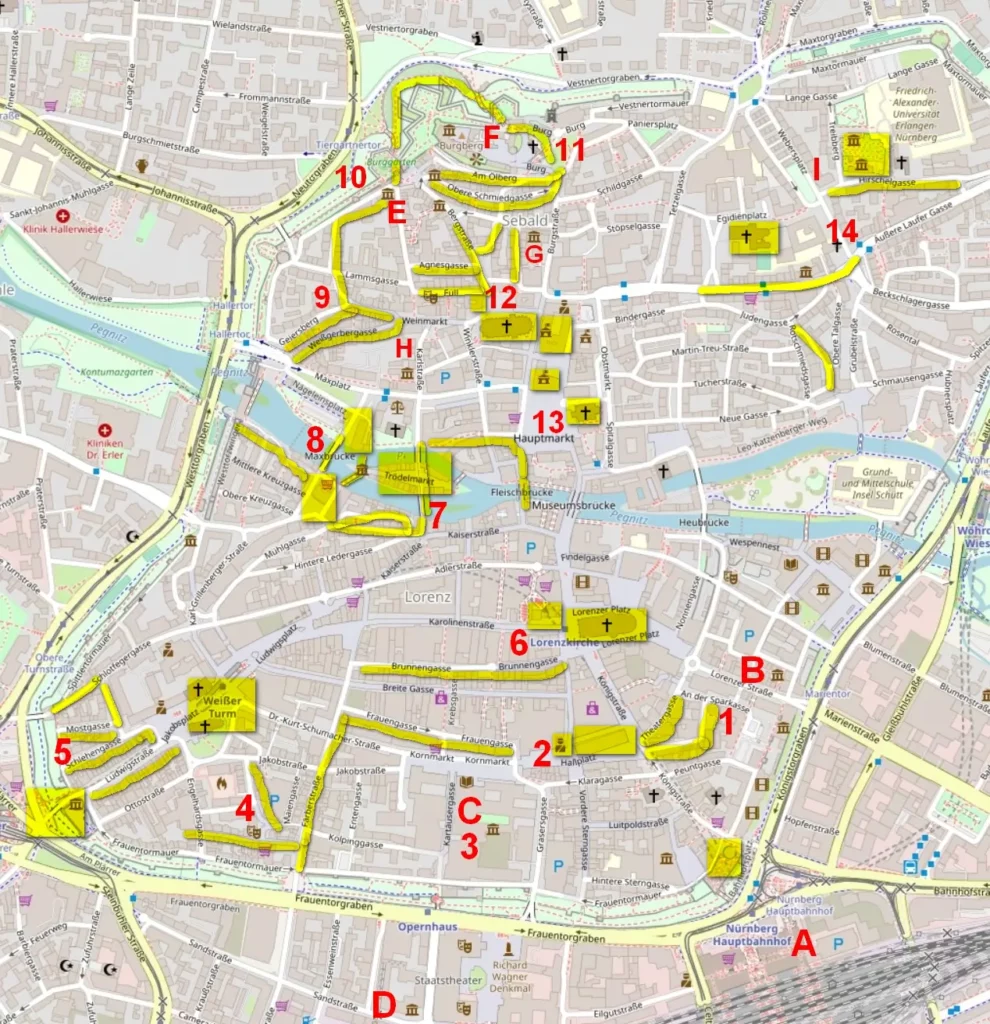
Section 1. From the train station to the Deutsches Museum
So, let’s start our journey from the station (A). The largest number of people walk along the diagonal Königstrasse – Hauptmarkt – Burg. We will go through a zigzag. Some (sometimes a little) remains of old Nuremberg can be found in these streets.
We will not turn to the left of Konigstrasse near the station – there is the local “red light district”. Let’s turn better to the right. But before that, you can look into the Handwerkerhof right in front of the large round tower. Here local craftsmen produce and sell edible and inedible souvenirs.
1. So, we are interested in the streets Theatergasse and Johannesgasse with houses of the 15-16-17 centuries. A little further there is the Kühnertgasse with a small museum (B) dedicated to the life of Nuremberg craftsmen from the Middle Ages to the Biedermeier.
2. We return back to Königstrasse. Opposite Theatergasse – Hallplatz with a large former granary Mauthalle (late 15th century). The Pfannenschmiedsgasse street goes to the side – here the Zeughaus (16th century) is interesting.
3. From here we can turn left to the Germanisches Nationalmuseum (C). In this large museum dedicated to the cultural history of German-speaking regions, you can see prehistoric finds (for example, one of the golden hats), paintings (for example, Dürer, Cranach, Rembrandt), sculptures, decorative items, textiles, jewelry, furniture, toys, weapons, scientific inventions (for example, the oldest globe), musical instruments. The museum occupies the premises of a former monastery, but after the wartime destruction it was rebuilt.
If you go further, beyond the city walls, cross the main road and walk a little more to the railway, there will be a railway museum – Deutsche Bahn museum (D). It’s absolutely amazing. Here you can see locomotives from different centuries, real ones and models. There is a special children’s department.
Large modern trains are displayed in a separate hangar. It closes with the onset of twilight, and the museum itself is open a little longer. Therefore, it is wiser to start with a hangar.
4. From the museum you can return and walk along Frauengasse and Färberstrasse. Or you can walk along a piece of Frauentormauer wall to Pfeifergasse (“lane of pipers”) and Zirkelschmiedgasse (“lane of mechanics”).
Section 2. From the church of St. Jacob to St. Lawrence
5. Next area: Ludwigstrasse, Schlehengasse, Mostgasse, Schlotfegergasse (“lane of chimney sweeps”). There are two churches nearby: St. Jacob and St. Elizabeth.
Church of st. Jacob was built on the site of an old chapel in the 13th century and belonged to the German Order. During the war, the altar of the 13th century, the choir of the 14th century, sculptures, paintings and stained-glass windows were preserved.
6. Let’s take a look at the White Tower (Weiße Turm, the remainder of the city’s fortifications of the 13th century) and the ugly fountain behind it. And then we will return along Brunnengasse to the main tourist diagonal to the very tall beautiful Gothic church of St. Lawrence (Lorenzkirche).
The church was built in the 13th century. Of particular interest is the western façade, preserved from the 14th century, with a rosette and a carved portal. The church closes quite early. On Mon-Sat it is open from 9.00 to 17.00, on Sun. only from 13.00 to 16.00 (on Advent until 18.00).
Opposite the church, do not miss the Nassauerhaus – the only surviving fortress house in Nuremberg from the end of the 12th century.
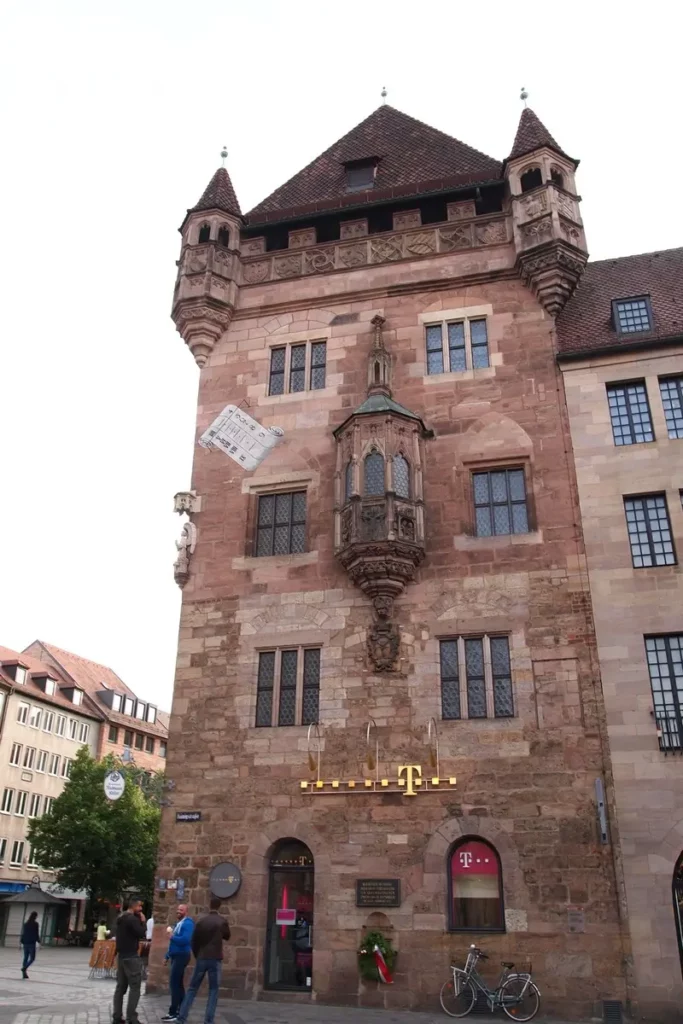
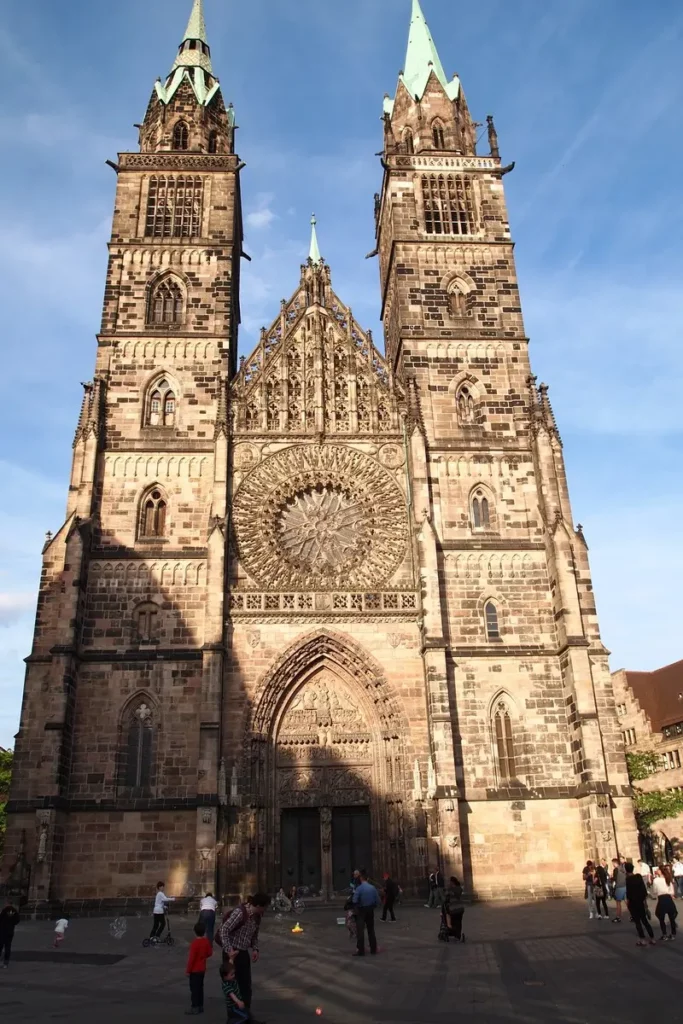
Section 3. Around Pegnitz
7. Now let’s wander around the Pegnitz river along its bridges. And let’s start with Fleischbrücke – the “meat bridge” (late 16th century, Renaissance). Then we will go to the Trödelmarkt (formerly called Säumarkt – the “pig market”, and now the “junk market”) and see Karlsbrücke (the northern part was built in the 15th century).
The best-preserved part of Nuremberg begins here: Obere Wörthstrasse, Untere Wörthstrasse, Unschlittplatz. This name comes from the Unschlitthaus (“house of beef fat”), one of the 7 granaries in Nuremberg. There was also the organization that controlled of the urban monopoly on fat and lard. Here all butchers were supposed to sell fats.
8. Further Untere Kreuzgasse, Maxbrücke – the oldest stone bridge in Nuremberg (mid-15th century).
Henkersteg – a wooden bridge to the island and Henkerturm tower – part of the city fortifications (14th century).
On the other side of Pegnitz is a large half-timbered building Weinstadel (mid-15th century) – originally a hospital, then a storage of grape juice.
Henkersteg
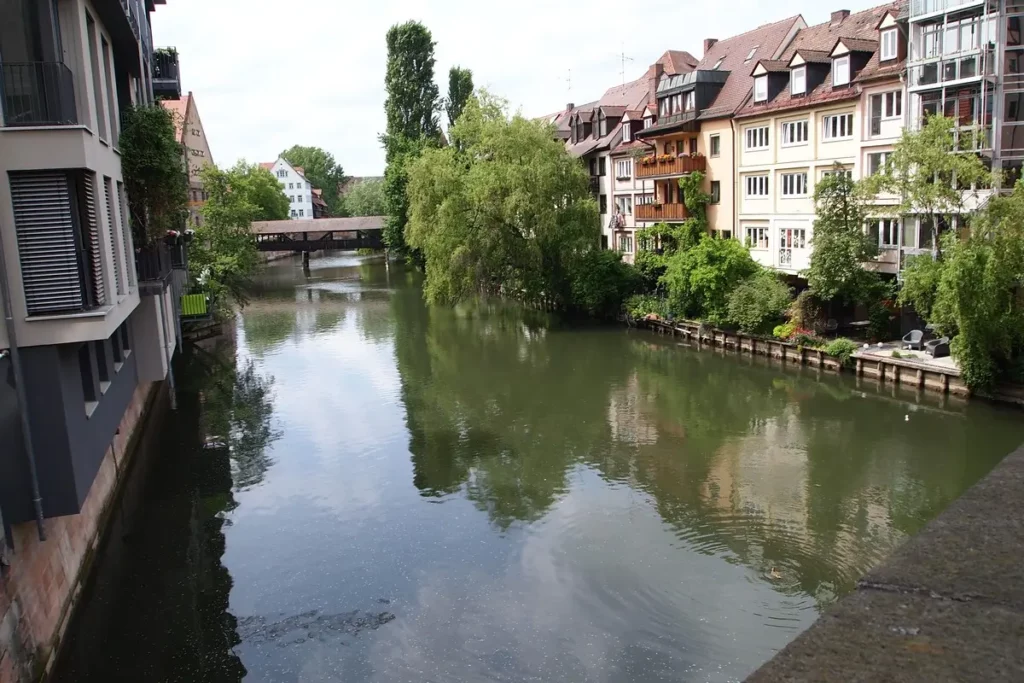
Section 4. Around the fortress
9. We begin to climb to the fortress. Interesting streets are: Geiersberg, Weißgebergasse (the best-preserved ensemble of old houses in Nuremberg), Irrerstrasse, Radbrunnengasse.
10. Dürer Museum (E) – Albrecht-Dürer Haus.
The house was built in 1420. From 1509 to 1528, Dürer lived in it with his family and apprentices. Since other people lived there after Dürer and his wife, it is natural that there is no original furnishings.
You can see an old kitchen, two rooms furnished by one of the owners in the neo-Gothic style in the 19th century, a large room upstairs – presumably a workshop with tools from that era. Particular attention is paid to the production of engravings. The museum hosts temporary exhibitions of Dürer’s works and graphics.
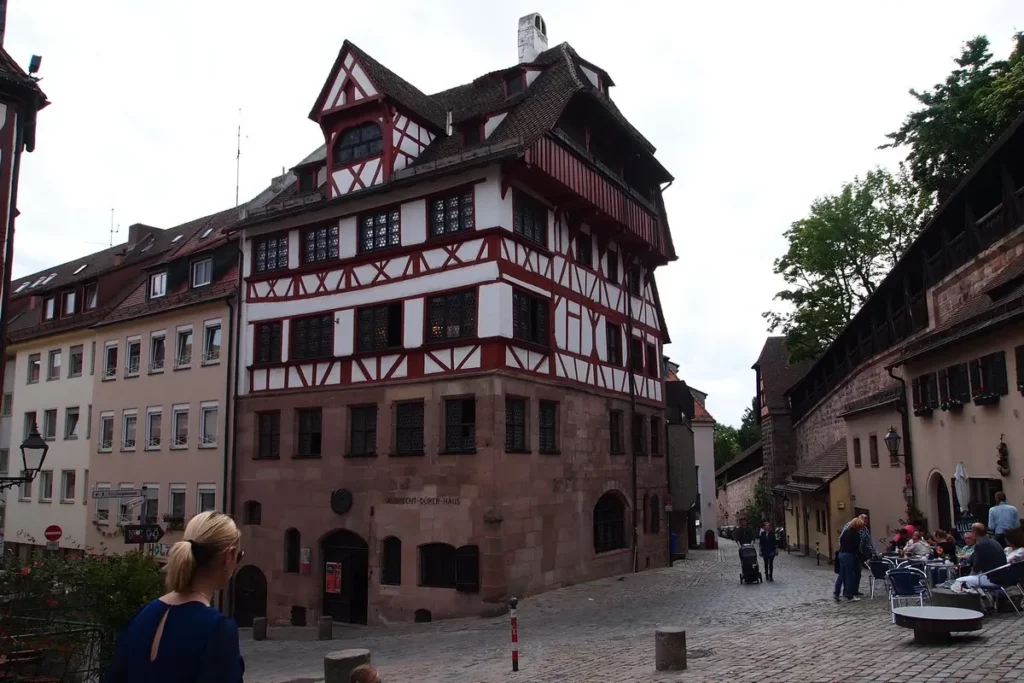
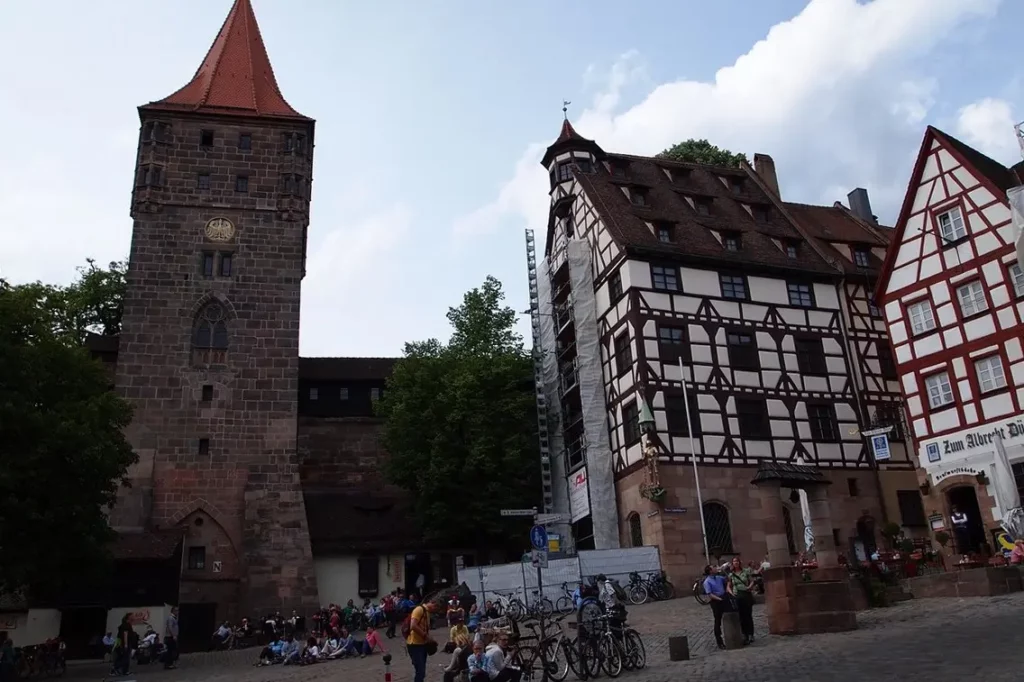
11. We ended up at the very fortress (F), but not at its entrance. The Kaiserburg fortress looks great from the side on postcards. But, interestingly, from the city you can hardly see it from anywhere. Only from the church of St. Lawrence a piece of the fortress is visible.
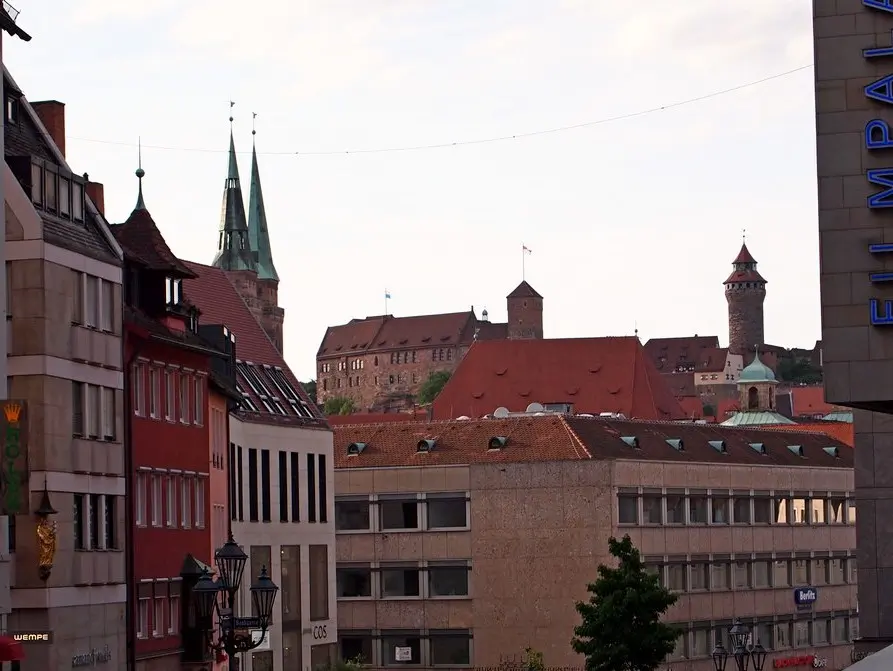
And I did not find viewing platforms from where the fortress is photographed. The maximum that was found – twice a week, you can climb the tower of St. Sebald.
To get inside the fortress from the Dürer Museum, you need to go around it:
- or along the streets am Oelberg or Schmiedgasse up to Burgstrasse. It is very steep. Here you can clearly see the rock on which the fortress stands.
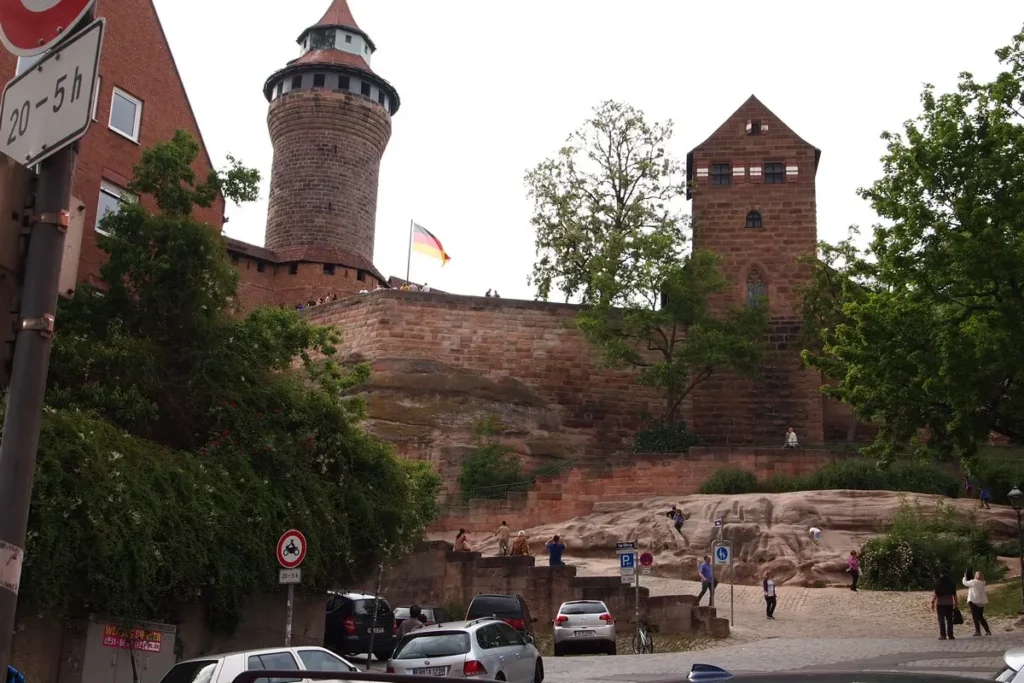
- or a more convenient way: go under the wall along the tunnel opposite the Dürer house-museum, then along the bridge over the moat and again under the walls with a gradual ascent to the fortress.
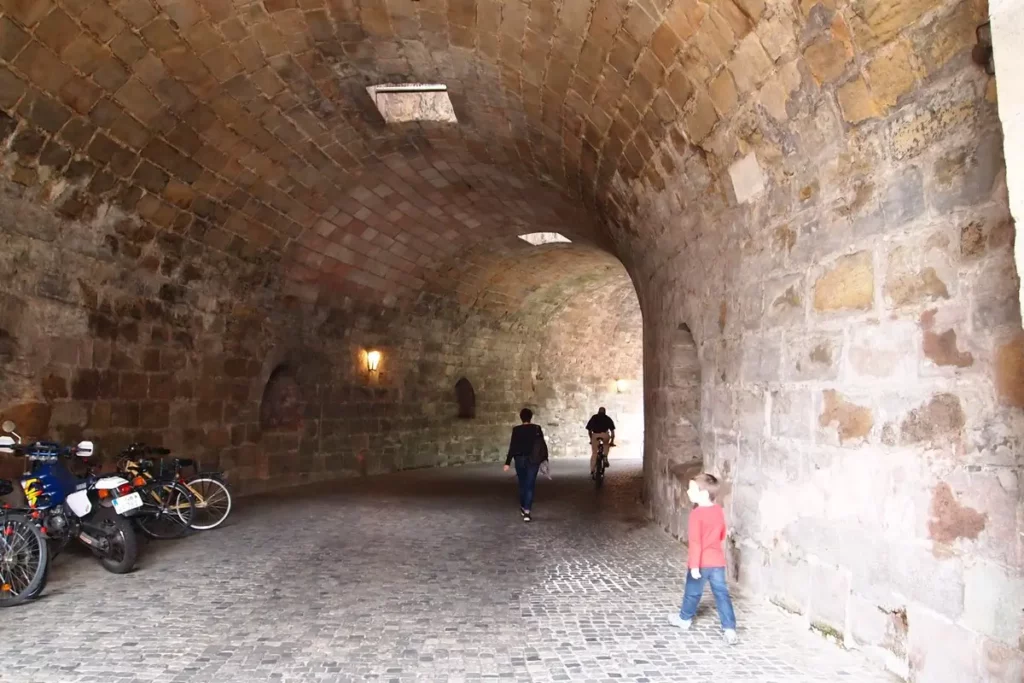
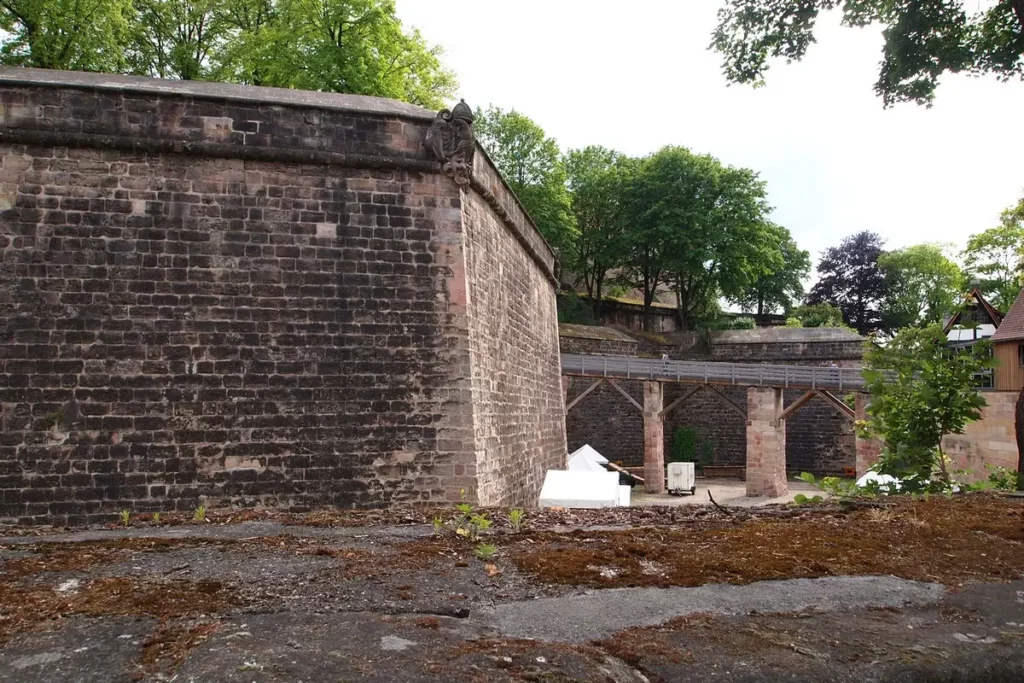
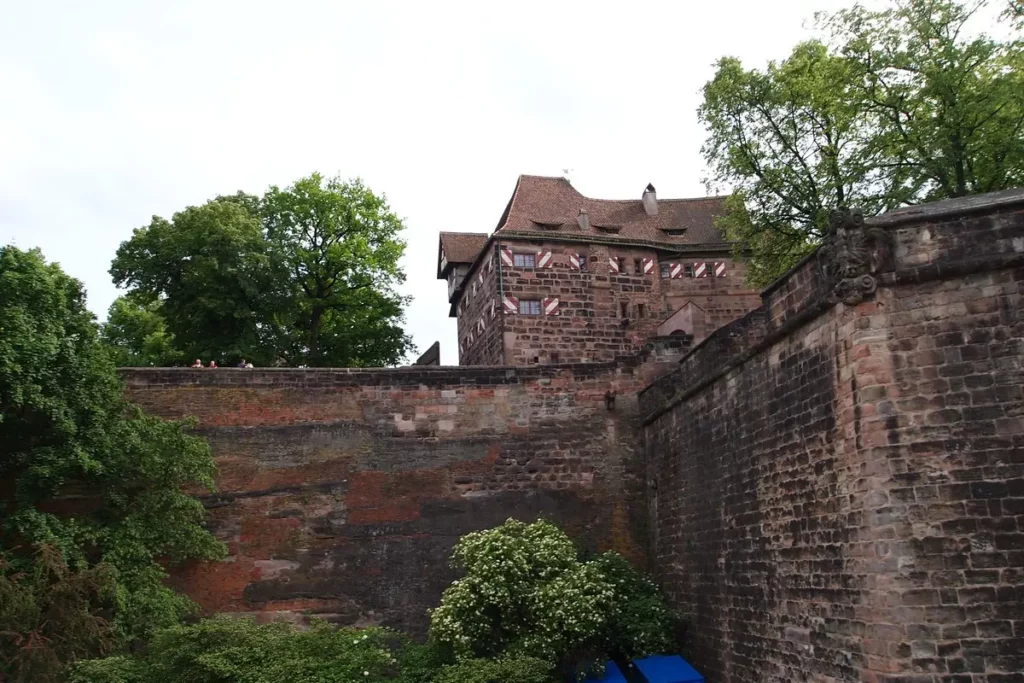
Follow me
5. Kaiserburg
Like any other self-respecting fortress, the Nuremberg fortress was rebuilt several times, expanded and altered. There are three parts: the Kaiser’s fortress (Kaiserburg), the burgraves fortress (Burggrafenburg) and the buildings built by the city (Reichsstädtische Bauten).
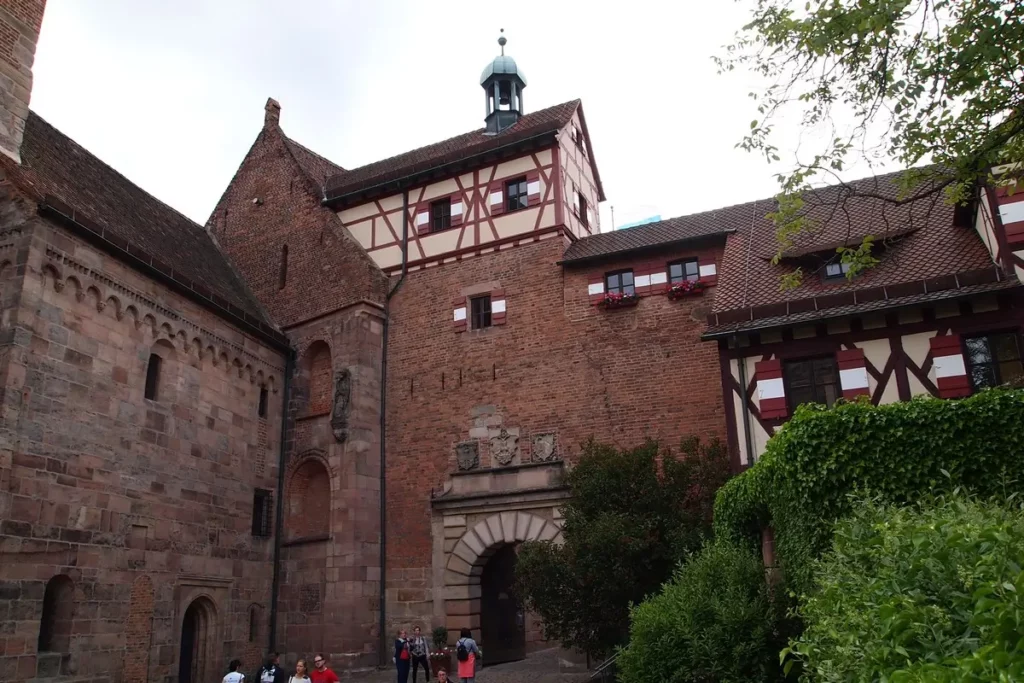
The first buildings appeared here before 1000, but there is no written data about them. The fortress was first mentioned at the beginning of the 12th century, as a county was established. From that moment until 1571, German emperors regularly stayed there, especially in the 12-13 centuries.
From the 14th century the city began to fight with the Hohenzollern counts for power. For example it built new buildings that disturbed the counts – Vestnertor and the Luginsland tower, which practically looked into the courtyard of the counts. In 1427, Count Friedrich of Hohenzollern sold his rights and title to the city. Er received Brandenburg, and the interests of the Hohenzollerns moved north.
Climbing the main steep ascent, we immediately find ourselves in the part of the Kaisers. It is also the most interesting and significant. The rest are administrative buildings. In a large house with a multi-storey roof, which looks like a palace, once contained grain, and now it is a youth hostel.
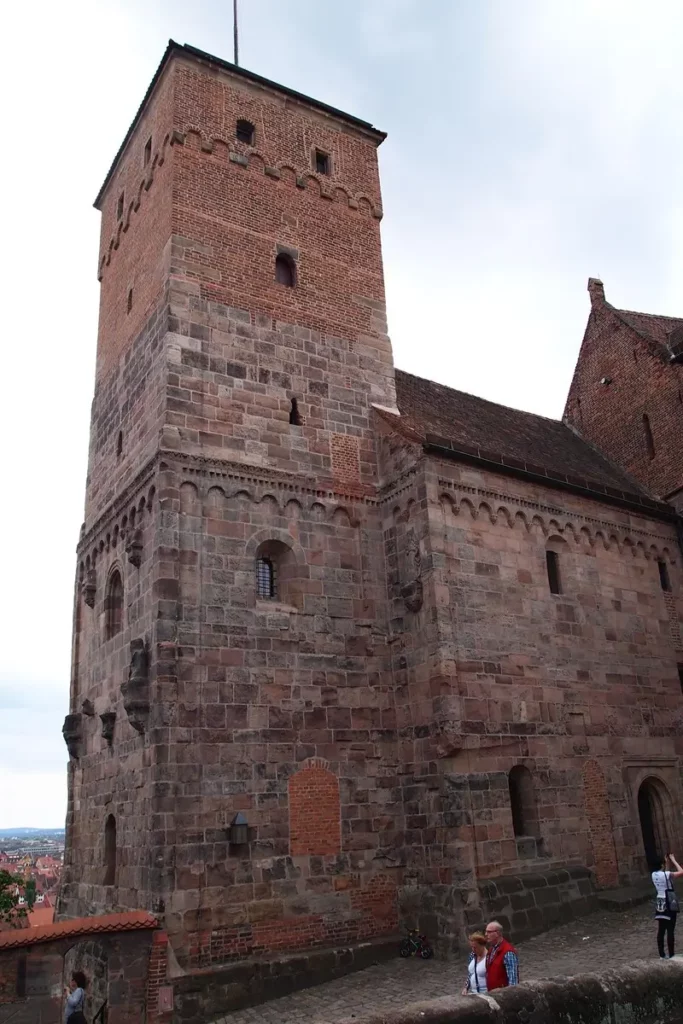
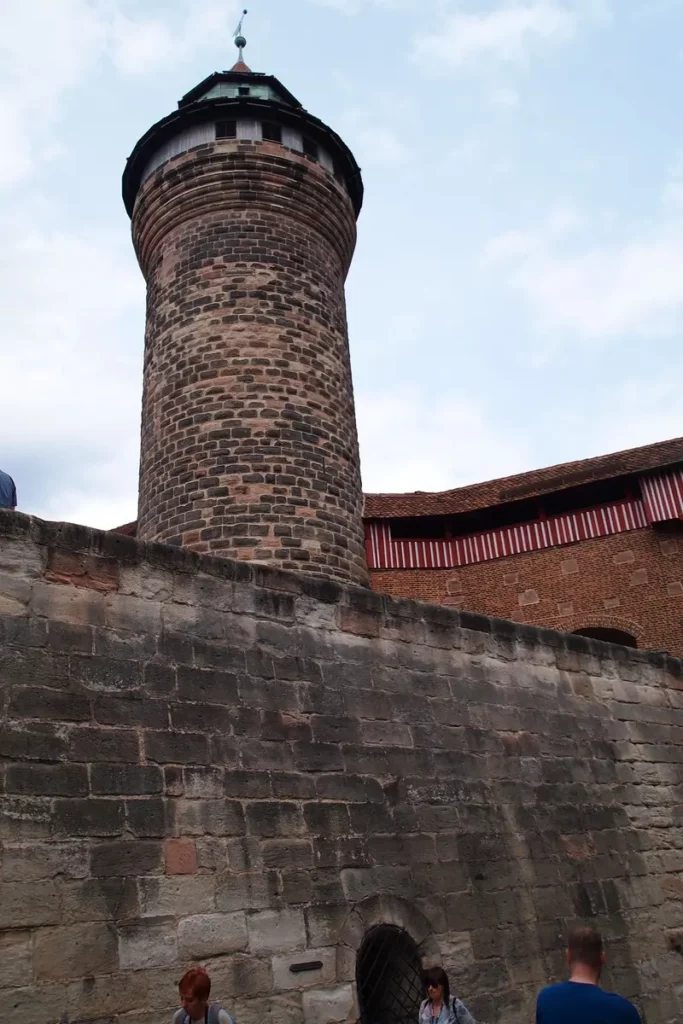
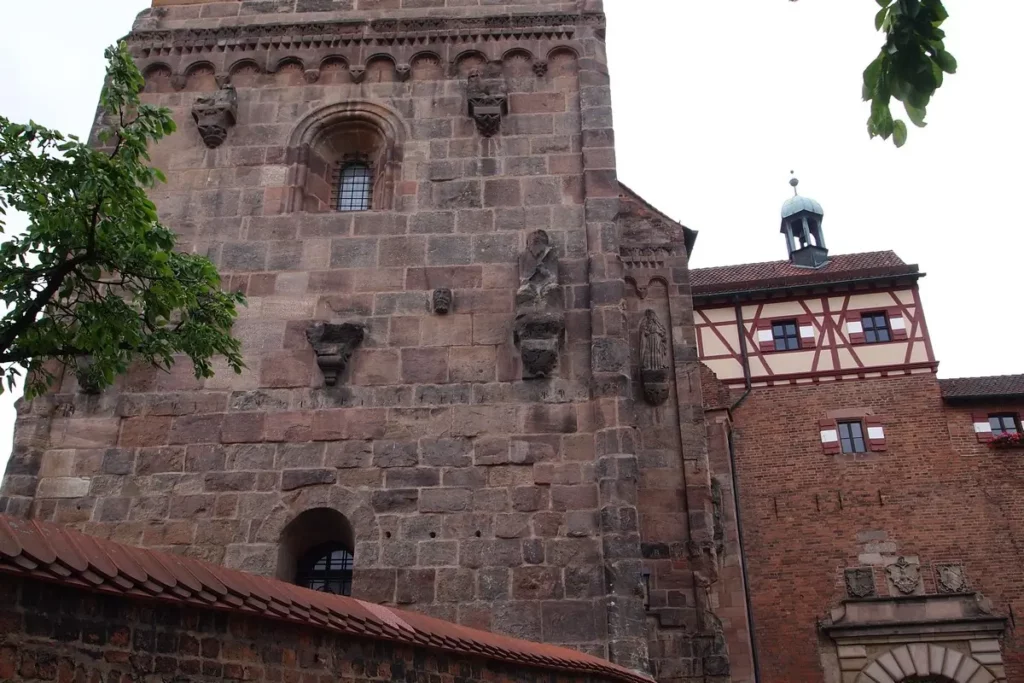
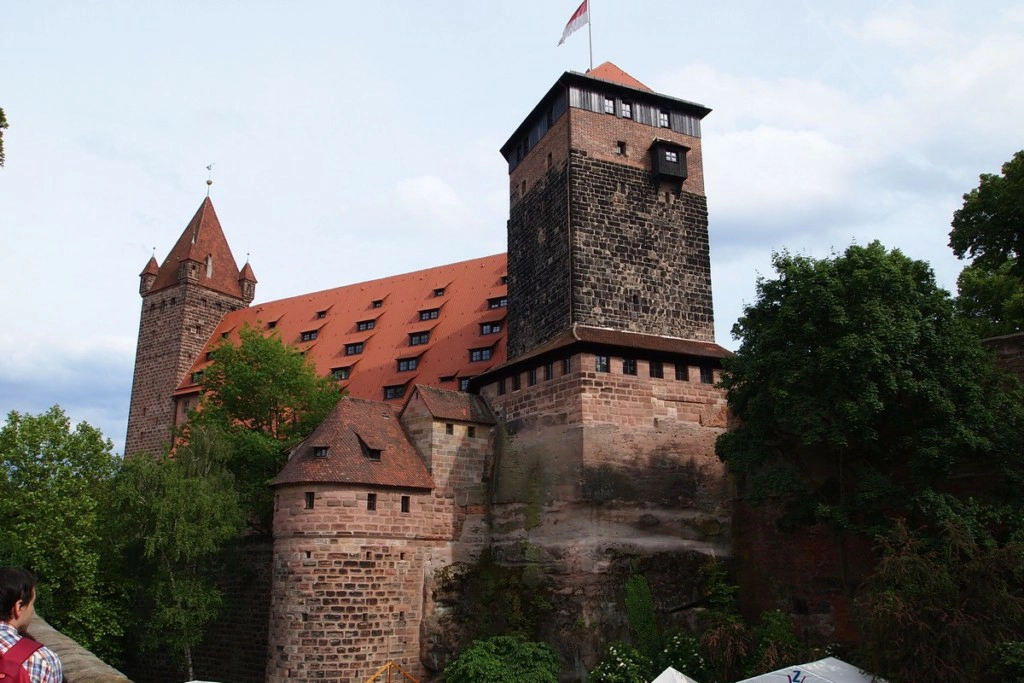
Buildings to visit: Kaiserburg, Sinwellturm (round tower) and Tiefe Brunnen (water well near the tower).
The current view of Kaiserburg dates back to 1440 – when the palace and other buildings were rebuilt.
Since the 12th century only the so-called double chapel has survived. The upper floor was intended for the nobility.
Palace was used only during the emperor’s visits. The counts lived in their own palace. Interiors of Kaiserburg have practically not survived. The exposition is small, you can get around everything in twenty minutes.
At the beginning of the route, the double chapel, view from top. Then several small rooms with weapons, models of the castle.
If there is a lack of time, it is enough to look the castle only outside, especially since the entrance to the territory is free.
The Luginsland Tower, which the city built as part of a strategy to fight the Counts, and a former granary / stables (now a youth hostel)
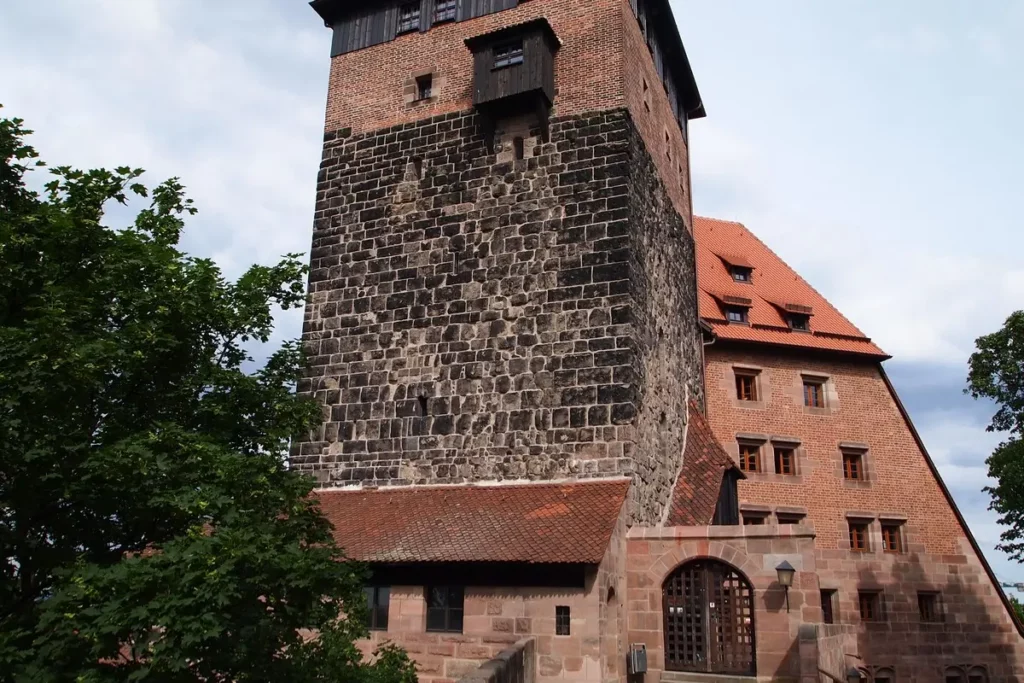
On the way back, you can bypass the streets under the fortress: Obere Schmiedgasse, Obere Krämergasse, Untere Krämergasse, Agnessgasse, Bergstrasse, Füll. Those wishing to get acquainted with the history of the city in more detail can visit the museum of the city Fembohaus (G).
6. Cathedral of St. Sebald and Main Market Square
12. We go down to the Cathedral of St. Sebald (Sebalduskirche, 13th century, Romanesque style with Gothic elements). You can see stained glass windows, a carved altar, the tomb of St. Sebald. He is the patron of the city. You can also climb the tower with a guided tour – on Thu at 18.00 and on Sat at 16.30 (until early October).
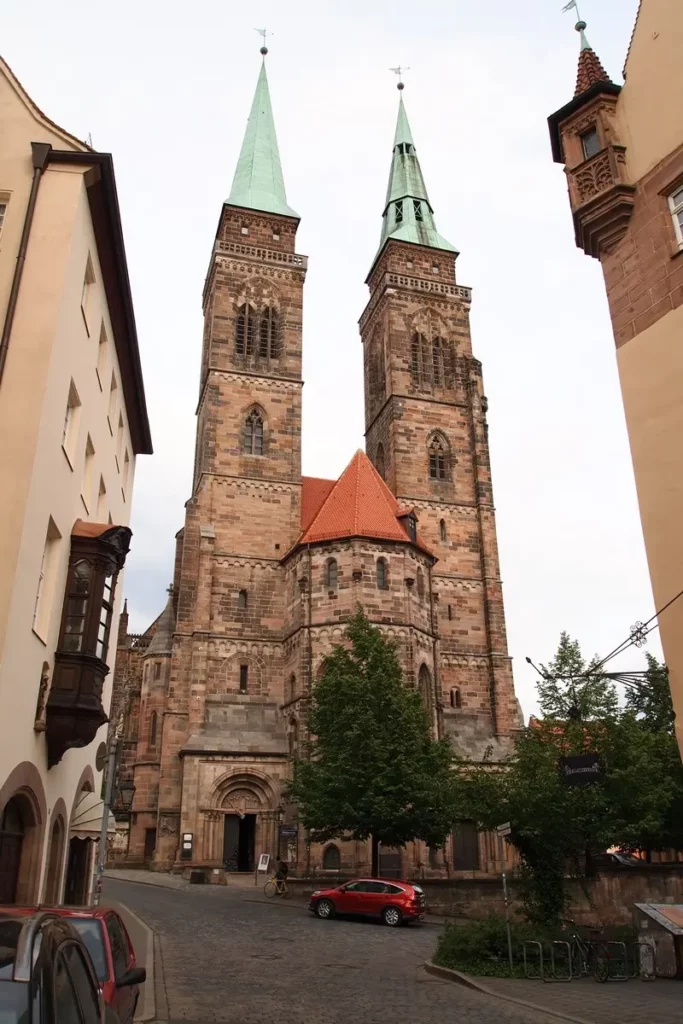
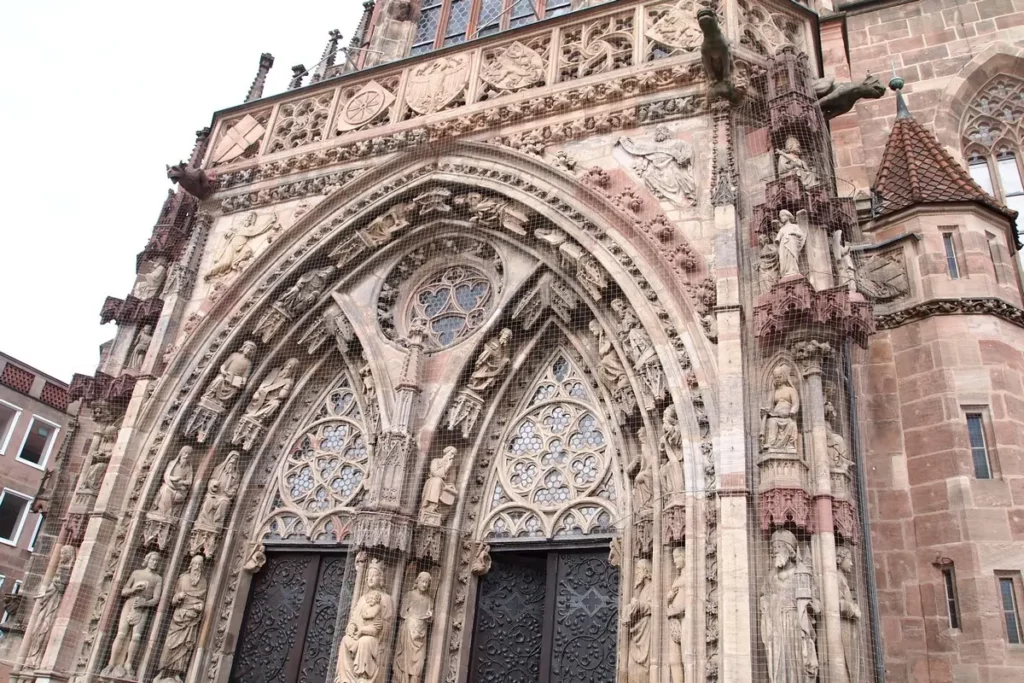
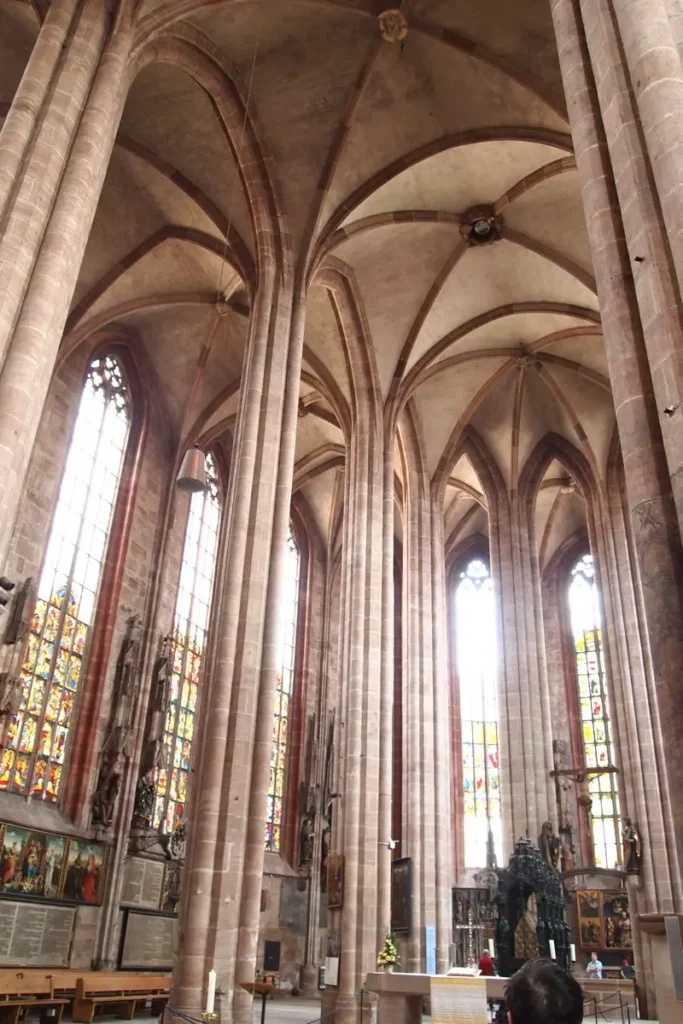
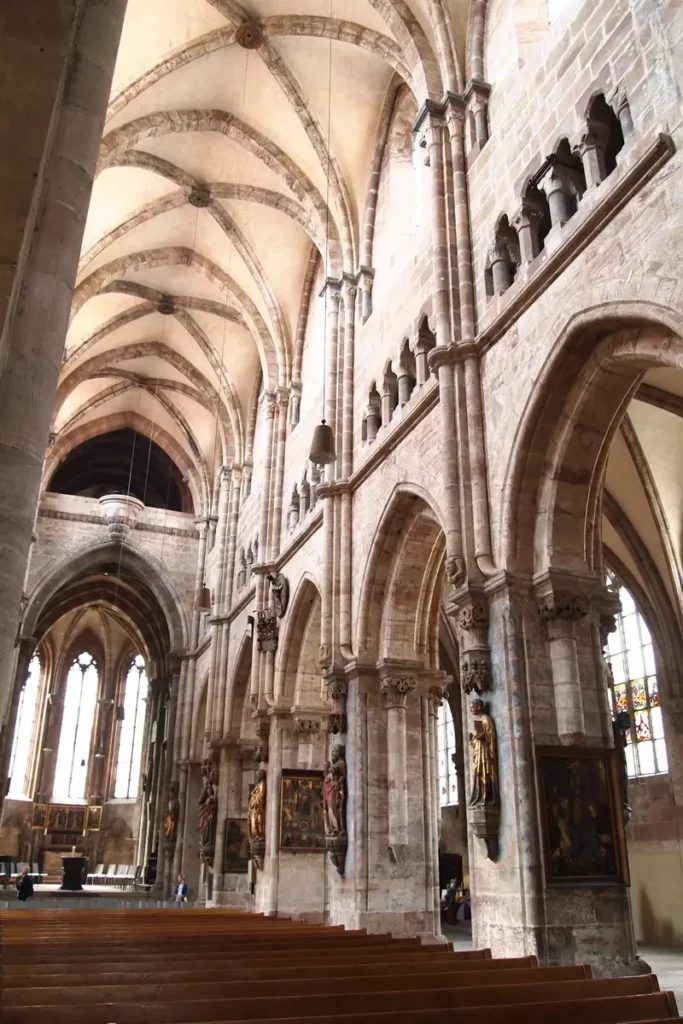
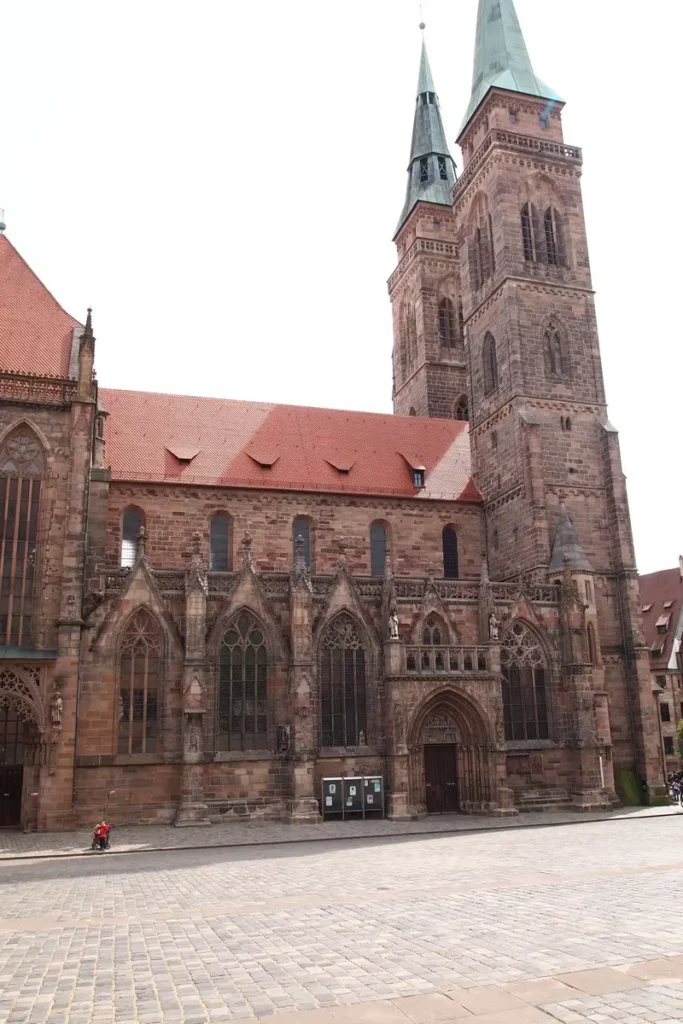
On the Albrecht Durer Square, near the cathedral, look at the Pfarrhof (pastor’s yard, 14th century) with a carved bay window Chörlein. It is copy. The original is in the German National Museum.
Cathedral of st. Sebald with the bay window on the photo.
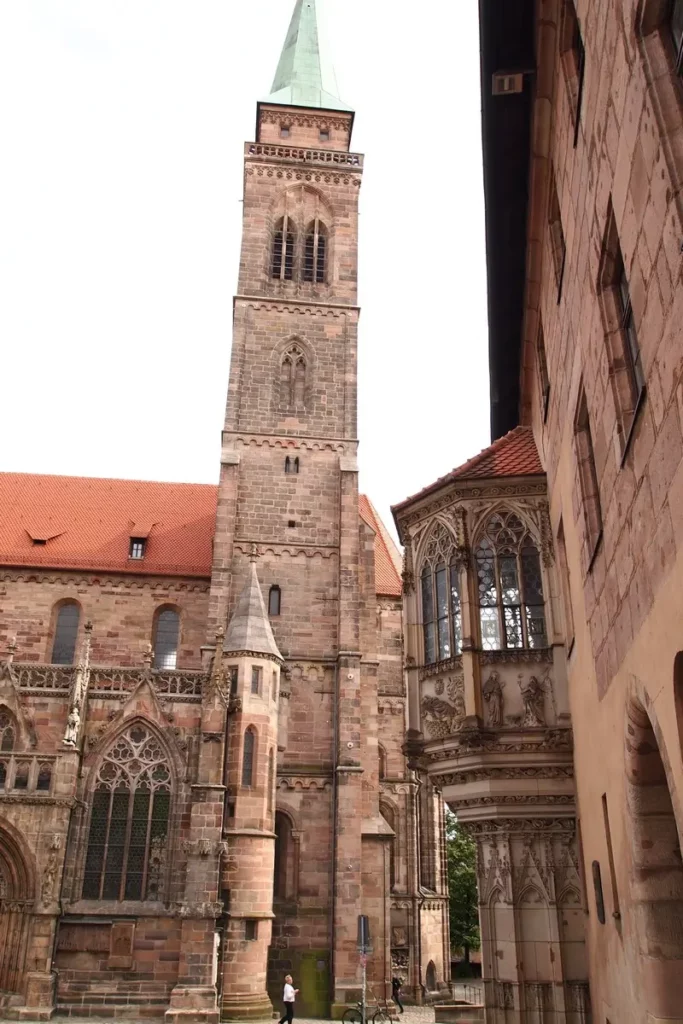
Not far from the cathedral there is a toy museum (H) – a collection of toys from antiquity to modern times.
13. Finally, we go to the main square – Hauptmarkt. The most interesting here are:
- the Schöne Brunnen fountain (built in the 14th century, has been repeatedly restored, now there is a copy on the square, and the original is in a German museum)
- and the Church of Our Lady.
The Church of Our Lady (brick Gothic style) was built on the site of a synagogue destroyed during the Jewish pogrom in the 14th century. She suffered greatly during the war.
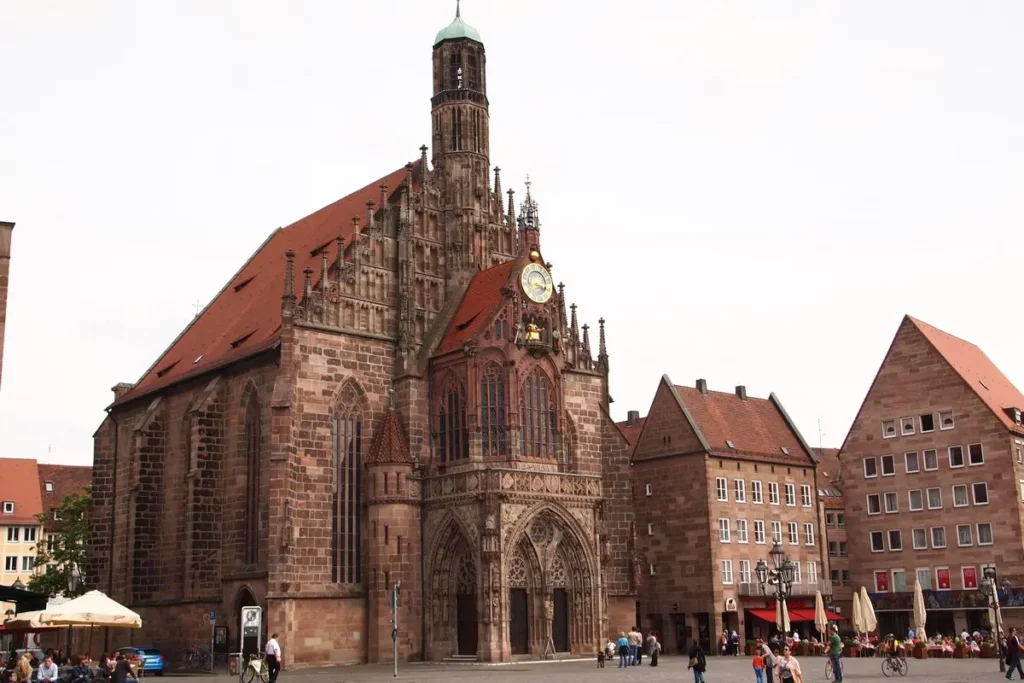
The western façade, created in the 15th century by Adam Kraft, is especially beautiful. To be honest, because of this ornate facade dominating the square, I thought for a while that this is the town hall. And the town hall (16-17 centuries, Renaissance) actually faces the square sideways. In fact, it is easy not to pay attention to it at all.
In the inner square of the town hall there is another interesting and one of the oldest fountains depicting a peasant carrying two geese (Gänsemännchenbrunnen).
Figures of mechanical clocks (early 16th century) play on the Church of Our Lady at 12 noon. The composition is dedicated to the Golden Bull of Charles 4, according to which the election of the new emperor was announced by the princes-electors.
Section 7. University quarter
14. To the east of the main square is the university quarter. You don’t have to go here, but those who have not walked enough can look:
- Hirschelgasse (see the Tucher Schloss house with a museum showing the life of patrician families in Nuremberg (I),
- the Church of St. Egidius with Euchariuskapelle – one of the oldest in Nuremberg
- Innere Laufer Gasse (Schlagturm tower – part of the fortifications of Nuremberg), Untere Talgasse.
Nuremberg Museums
A city with a fortress can be seen in half a day, museums will require additional time.
In addition to the already mentioned museums, there are:
- Dokumentationszentrum Reichsparteitagsgelande (Nazi Nuremberg),
- New Museum (contemporary art and design),
- Memorium (the place where the Nuremberg process was held),
- Amber Museum (Breite Gasse 40, 2nd floor, 11.00-17.00),
- industrial culture museum (steam station, school museum, printing yard, dentist’s office, bicycles and much more),
- communication museum (originally postal museum),
- fire museum,
- pigeon museum,
- guided tour of the underground labyrinths of Nuremberg (Bergstr. 19),
- planetarium.
Please note: a ticket to any of the city’s museums (Dürer’s House Museum, Toy Museum, Tucherchloss Museum, Fembohaus Museum, Industrial Culture Museum, Memorial, Dokumentationszentrum) with a surcharge becomes a day ticket to all other city museums. If you have a Nuremberg Card, a single museum ticket can be used as a day museum card at no additional cost.
Out of center and around Nuremberg
- Zoo (you can read more about the zoo and the dolphinarium in another post).
- Fürth – you can see the old center (unlike Nuremberg, Fürth has preserved 90 percent of the buildings) and visit the thermal pool. On the outskirts of Fürth there is also the very well-preserved Neuhof castle, owned by the German National Museum.
- With children – Playmobil FunPark в Zirndorf (www.playmobil-funpark.de).
Nuremberg as a base for travel also allows you to visit various cities:
Bamberg (45 minutes by train),
Regensburg (1 hour),
Bayreuth (50 minutes),
the Franconian Switzerland region with castles, fortresses and caves (between Bamberg, Bayreuth and Nuremberg).
All these cities are described from separate pages. See also maps of attractions by region.
Next – Tiergarten Nürnberg.
Nuremberg is a part of Castle road (Burgenstraße – #burgenstrasse)
Do you enjoy the site without cookies? This means that I work for you at my own expense.
Perhaps you would like to support my work here.
Or change your cookie settings here. I don’t use personalized ads

